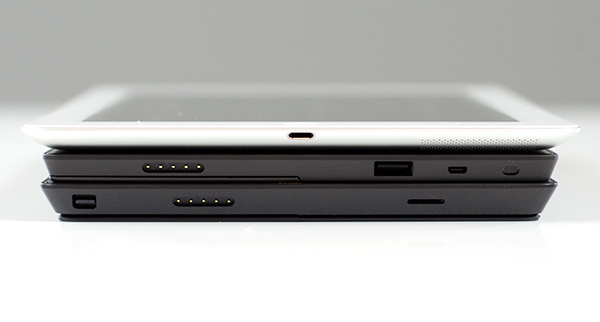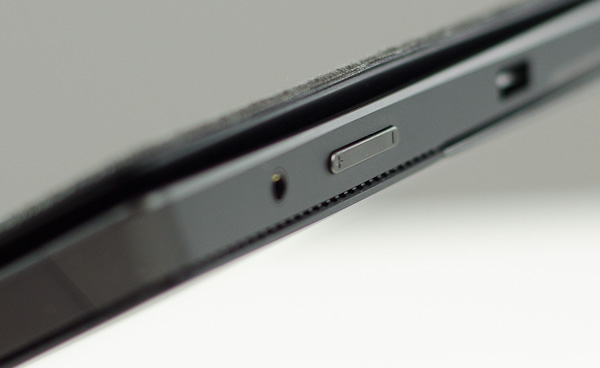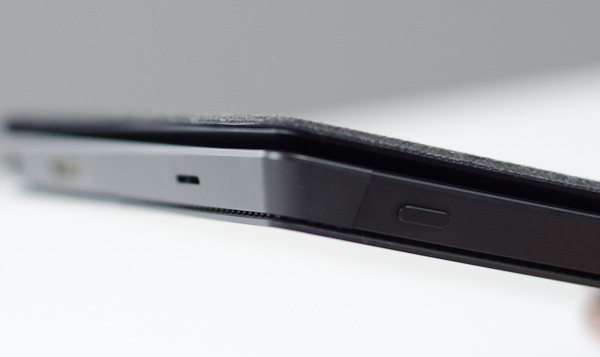Microsoft Surface Pro Review
by Anand Lal Shimpi on February 5, 2013 9:00 PM ESTSurface Pro Design
When I first saw Surface Pro, the Microsoft rep giving me the demo did a simple test. He stood Surface Pro right next to Surface, with the same start screen, and asked me if I could tell the two apart. The planar dimensions of Surface Pro are identical to Surface RT. Both feature the same sized 10.6-inch display, the same capacitive Windows button and the same 1-inch border around the screen. Looking head on, the only way you can tell the difference between Surface Pro and RT is the former’s 1080p display does make text a bit sharper.

Surface RT (left) vs Surface Pro (right)
Turn the two tablets to the side and the differences quickly become evident. Surface Pro is over 40% thicker than Surface RT (13.7mm vs 9.3mm). While the latter was of a similar thickness to an iPad with Retina Display, Surface Pro is clearly in a different league of dimensions.
The thickness of Surface Pro doesn’t really impede its portability, but the weight definitely makes it a lot less pleasant to carry around. Surface RT was already heavier than the competition but it hid its weight well. Surface Pro is just heavy for a tablet. I wasn’t originally impressed by the Surface RT form factor, but in switching between the RT and Pro models I immediately wish that Surface Pro came in the RT chassis and Surface RT came in something even thinner and lighter.

Surface Pro (left) vs. iPad 4 (right)

From top to bottom: iPad 4, Surface RT and Surface Pro
Shift the comparison to Ultrabooks however and all of the sudden Surface Pro seems quite light. It’s lighter than an 11-inch MacBook Air and Acer’s 11.6-inch Aspire S7 (although with optional keyboard cover it is heavier). It’s all about perspective. Compared to an iPad, Surface Pro is heavy, but compared to an Ultrabook or MacBook Air it’s light. The Pro model embodies the vision Microsoft had for the Surface family: to create a new type of device somewhere between a tablet and a notebook. That’s not to say there’s not room for improvement in the physical department. Surface Pro will likely go on a diet as it’s given more power efficient silicon, but even then you’ll always be able to build something thinner and lighter based on slower hardware, or go thicker and heavier with a notebook.
The fit and finish of Surface Pro are just as good as Surface RT. The tablet is built out of the same injection moulded Magnesium process (VaporMg) as Surface RT, however the chassis itself is somewhat simplified. While Surface RT featured three discrete VaporMg components (frame, back and kickstand), Surface Pro is made up of only two (single piece frame+back and kickstand). The result is no different to the end user, but the simplification on the assembly side is likely better for Microsoft.
I am fine laying the same praise on Surface Pro’s build quality as I did on Surface RT. The unique finish doesn’t feel like the aluminum we’re used to seeing on iPads, and definitely feels better than the plastic we’ve seen elsewhere. The VaporMg surface doesn’t feel like it would scratch easily, and after a few months with Surface RT I don’t see any visible scratches on my unit.
Surface Pro’s construction feels more utilitarian and understandably more oriented towards productivity, just like its little brother. I still believe that the Surface lineup is as much about Microsoft showing that it too can build high quality devices as it is about getting into the tablet market. If we compare it to the iPad, Surface Pro feels just as well built, if we compare it to every Windows RT and Windows 8 tablet or notebook on the market today - it’s worlds better. Say what you will about Microsoft entering the PC hardware business, but as of today Microsoft builds the best Windows RT and Windows 8 hardware on the market. If I ran a PC OEM I wouldn’t be angry at Microsoft, I’d be angry at myself for letting this happen.
Surface Pro retains the integrated kickstand from Surface RT, although the kickstand has been beefed up to accommodate the heavier tablet. Surface Pro’s kickstand keeps the device propped up at a fixed angle of 26-degrees away from the vertical axis. The rear facing camera is also angled to compensate (it shoots parallel to the ground with the kickstand opened).
The kickstand is allegedly good for over a million open/close cycles and it still doesn’t feel like something that would break. There are only two hinges in the kickstand compared to three for the RT model.
The kickstand on Surface Pro feels different than the kickstand on Suface RT. The Pro kickstand feels lighter and sounds less like metal and more like plastic if you tap on it. Feel around on the underside of the kickstand and you’ll notice a coating that seems to dampen sound and perhaps add some structure reinforcement to the design. Microsoft had to thicken the kickstand to support the added weight of the Surface Pro, but the difference is on the order of a fraction of a millimeter.
The tweaked kickstand does have different acoustics than Surface RT’s kickstand. While the latter sounded a lot like a thin metal door shutting, the Pro’s kickstand is far more muffled. I’d almost say it’s preferable.
Thankfully the kickstand’s functionality hasn’t been marginalized in the transition to the Pro. It’s still a highly integrated and very important part of the Surface experience. It’s simple to flip out and perfect for use on desks. You can make the kickstand work on your lap or chest if you’re lying down, but it’s not ideal for either unfortunately.
The more I use Surface (Pro and RT) the more I feel that Microsoft needs to pursue something a bit more flexible than the fixed 26-degree kickstand. The biggest issue by far is in-lap use with one of the keyboard covers attached. Depending on your seating position, the 26-degree angle that the kickstand opens at might be too small. Mechanically I don’t know the right solution for Microsoft but I do feel like for the kickstand to realize its true potential, it needs to be able to open and hold at multiple angles. It doesn’t necessarily need to have support for infinite angles, maybe even a few would work, but I do believe it’s necessary going forward.













228 Comments
View All Comments
kyuu - Friday, February 8, 2013 - link
I'm looking to get a mobile device with part of my tax return. I have zero interest in an iOS or Android tablet. What I'm looking at currently:1) Vizio's Hondo-based Tablet PC that was shown at CES.
2) Vizio's 2nd gen thin+lights, 14" model with touch screen and AMD A10
So basically, an ultrabook (thin+light) or a tablet are the only mobile devices I'm interested in. A normal laptop is too heavy and bulky for me to reguarly take with me out of the house. The Surface Pro would be in consideration, but the price is a little higher than I'm willing to spend (and should *really* include one of the covers).
atl - Wednesday, February 6, 2013 - link
42W 2 cell battery means 2 x 6 amps Li-ion cells (probably cut at 90% to increase cycles).As Li-ion charges from 0% to 70% at 1C, it requires 6amp charger.
Supplied charger just doubles the fast-charge period
kawatwo - Thursday, February 7, 2013 - link
Would like to see some Win 8 tablets with Core I3 and weight under 1.5 pounds. 2 pounds is a bit heavy for a tablet. Needs to include the Type keyboard as well. But overall what an awesome device. I'm sure other PC makers will get it right in the not real distant future.jeffkibuule - Friday, February 8, 2013 - link
Acer will have a newer version of the W700 with a 7W SDP Ivy Bridge chip that is 20% thinner than their current model (around 8mm), so it's certainly possible.phillyry - Saturday, February 16, 2013 - link
Graphics would blow on an i3 and make the touch based interface borderline unusable.Sabresiberian - Thursday, February 7, 2013 - link
I think Microsoft got into building their own hardware here because they felt forced to; no one was building the kind of quality device they wanted. I think Nokia and HTC need to step their games up too if they don't want a Microsoft phone to come along and take their business away (or relegate it to the cheap seats). I like this approach, and hope they do kick the phone industry on the pants, because none of them are what I'd really call "good". (I'm talking ALL smart phones, not just Win 8 phones - phones that really don't take much of a back seat to anything else on the market, overall.)THE one thing that kills the Surface for me is the 16:9 screen. that's okay for a tablet I suppose, but the Surface isn't about being "okay", and I think it's a slam in the face of a real quality experience. It puts the iPad out of the picture in every other way (in my opinion), but in this way, the iPad still pretty much kills everyone else.
Netscorer - Thursday, February 7, 2013 - link
Nobody else is building these because there is not enough demand. Microsoft can afford to chuck up all the costs that gone into Surface as marketing for Windows 8 OS, but if you are a typical PC manufacturer who operates on razor thin margins, you won't be able to afford to do what it takes to create an iPad killer. Add to this that neither Intel, nor Microsoft are giving you much of a slack on prices for core and Windows and that market for $1000+ laptops is already very small to begin with and you get the picture.SilthDraeth - Thursday, February 7, 2013 - link
I know it was a windows 7 tablet, but it to runs on a core i5 and 2gb of RAM. Have you guys never bench marked it, to include it in the graphs, in comparison to the newest?Silma - Thursday, February 7, 2013 - link
While it is perfectly clear to me that with a much bigger processor power consuption will be bigger than a way slower arm, hence it is to be expected that ultrabooks/surfaces can't have the same battery life as an iPad or nexus tablet, I don't understand the extreme différences seen in video playback benchmarks.On this benchmark I would of course expect Windows 8 offering to use a little more power than on an ios / android tablet due to the overhead of a bigger os, but here the différences are huge.
Here I think Microsoft and Intel could optimize greatly the power usage for 720p and 1080p mp4 playback.
andrewaggb - Thursday, February 7, 2013 - link
Agreed.